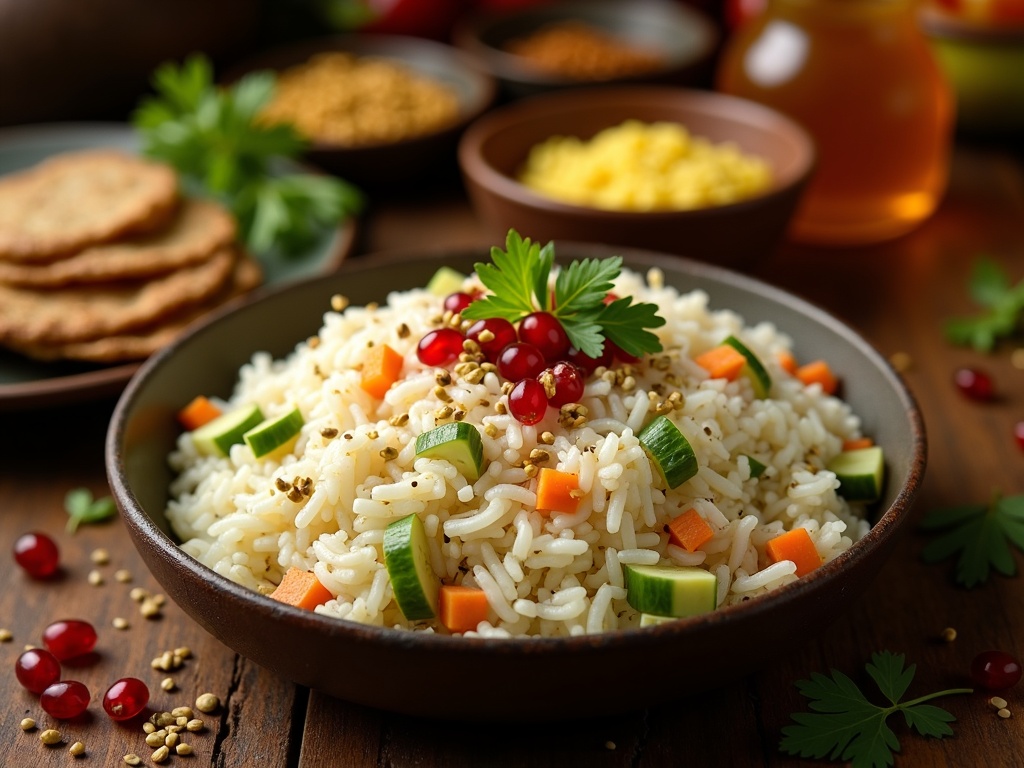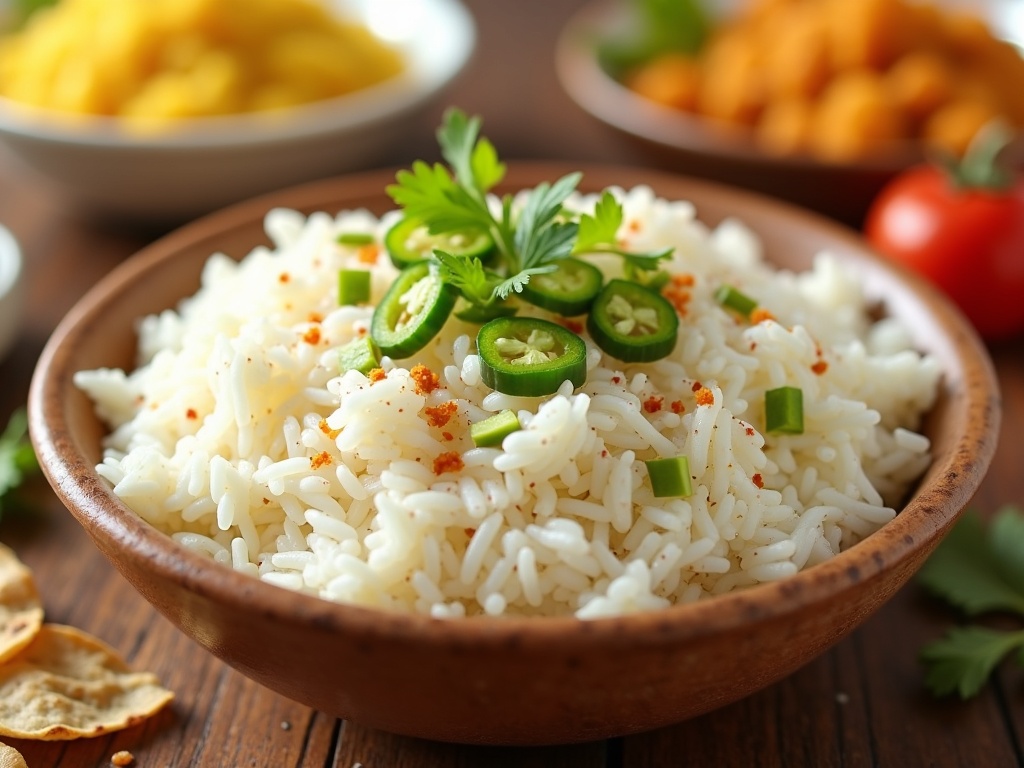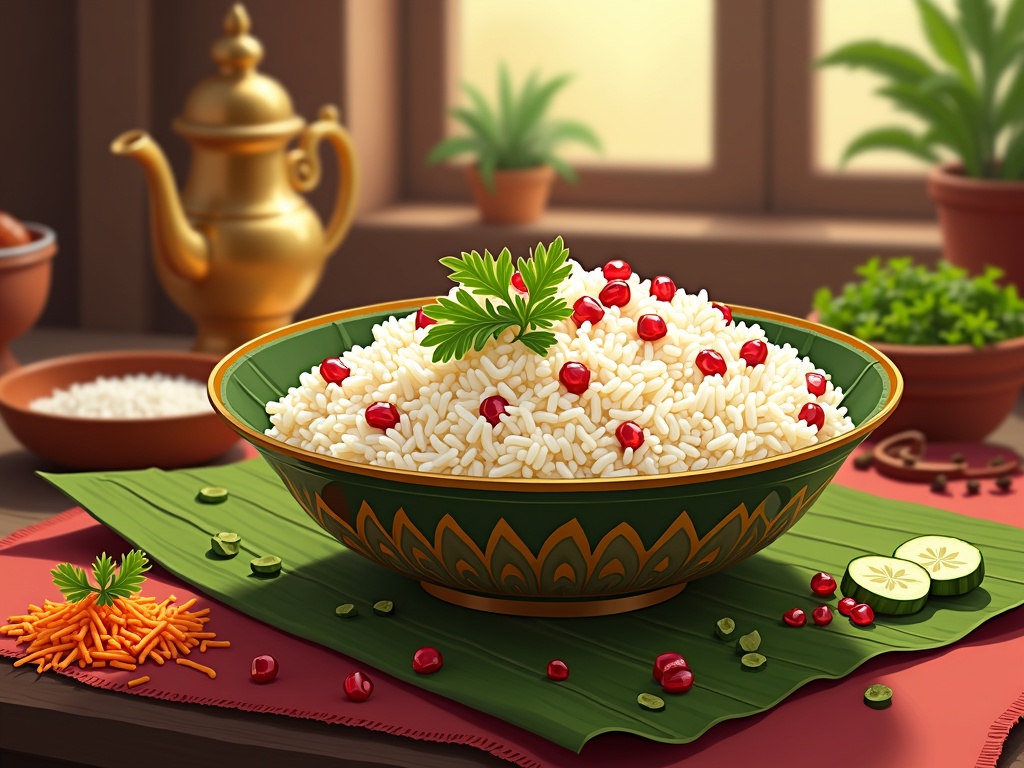Curd rice, a traditional South Indian dish combining cooked rice with yogurt, serves as both a cultural symbol and a probiotic powerhouse with exceptional gut health benefits. Its cooling properties make it perfect for hot weather, digestive issues, and recovery periods, while its adaptability allows for countless customizations with tempering spices, vegetables, and fruits to match different tastes.
Find In This Article
Key Takeaways
- Curd rice delivers significant probiotic benefits through live cultures like Lactobacillus and Bifidobacterium that support digestive wellness and immune function.
- At just 136 calories per serving with 4g of protein, curd rice offers a lighter, more digestible alternative to heavier rice dishes like biryani (300-400 calories).
- The dish holds cultural significance in South India, where it’s served at weddings, religious ceremonies, and family gatherings as a symbol of purity, prosperity, and healing.
- The perfect curd rice combines a 1:1 ratio of slightly overcooked rice to yogurt, with optional tempering of mustard seeds, urad dal, chilies, and curry leaves.
- Modern adaptations include meal-prepping components separately, incorporating it into specialized diets, and serving in creative ways like grain bowls or flatbread wraps.
Why Curd Rice is the Ultimate Comfort Food for Your Gut
I’ve always turned to curd rice during stomach upsets or on particularly hot days. This simple South Indian dish combines cooked rice with yogurt (curd) and optional seasonings to create something that’s more than just delicious – it’s also incredibly beneficial for gut health.
A Probiotic Powerhouse for Digestive Wellness
Curd rice stands out as an exceptional probiotic-rich food that helps maintain a balanced gut microbiome. The live cultures in yogurt, primarily Lactobacillus and Bifidobacterium, work actively to improve digestion and promote a healthy intestinal environment.
When compared to other probiotic foods, curd rice holds its own quite well. While kefir contains a wider variety of bacterial strains, and fermented vegetables like kimchi offer different probiotic benefits, curd rice combines probiotics with easily digestible carbohydrates that make it especially gentle on sensitive stomachs. This makes it particularly valuable when you’re dealing with digestive issues or recovering from illness.
A 200g serving of curd rice packs around 136 calories, with 4g of protein and 6g of fat. But the nutritional benefits extend beyond these macronutrients. The dish delivers a substantial amount of calcium for bone health, vitamin B12 for nerve function and red blood cell formation, and protein that supports muscle maintenance and immune function.
I’ve found that adding a touch of lemon to curd rice not only enhances its flavor but also increases its vitamin C content, making it even more beneficial during illness recovery.
Cooling Properties and Seasonal Benefits
One of curd rice’s most celebrated qualities is its cooling effect on the body. In regions with hot climates, like South India, this dish has been a staple for centuries precisely because of this property. The cooling nature of yogurt helps to:
- Balance body temperature during extreme heat
- Prevent heat-related digestive issues
- Provide hydration through its high water content
- Calm an inflamed digestive tract
- Offer relief from spicy food consumption
During summer months, I often prepare a larger batch of rice with cumin in advance, then mix portions with fresh yogurt as needed throughout the day. This makes it an easy grab-and-go meal that keeps my digestion happy during hot weather.
The adaptability of curd rice makes it especially valuable. You can enjoy it plain for maximum digestive benefits, or enhance it with tempered spices, cucumber, grapes, or pomegranate for added nutrition and flavor. Unlike heavier biryani dishes that might overwhelm a sensitive stomach, curd rice offers comfort without aggravating digestive issues.
For those with lactose intolerance, curd rice can still be accessible by using yogurt with live cultures, as these bacteria help break down lactose, making it easier to digest than other dairy products. This makes it an inclusive option for many dietary needs.
Its immunity-boosting properties shouldn’t be overlooked either. The probiotics in curd rice enhance immune function by strengthening gut barrier function and modulating immune responses. When I’m feeling under the weather, this simple dish provides both comfort and practical health benefits that help me recover more quickly.
The Sacred Bowl: Cultural Heritage of Thayir Sadam
Curd rice, known as Thayir Sadam in Tamil, holds a revered place in South Indian culture that extends far beyond mere sustenance. This humble dish commands respect at life’s most significant moments. I’ve noticed how prominently it features at South Indian weddings, typically served as the final course to balance the palette after spicy feast items. The cooling properties of curd rice make it particularly significant during religious ceremonies, where it’s offered as prasadam (blessed food) at temples throughout Tamil Nadu and neighboring states.
The symbolic significance of Thayir Sadam runs deep in cultural consciousness. When served on a banana leaf, particularly during auspicious occasions, it represents prosperity and abundance. The white color of the curd symbolizes purity, while rice signifies wealth and sustenance – together creating a powerful cultural symbol that’s shared across generations. Many South Indian households consider it incomplete to finish a meal without this sacred dish.
Healing Traditions and Community Bonds
Curd rice stands as the cornerstone of healing traditions in South Indian homes. During illness, particularly stomach ailments or recovery periods, it’s the first solid food offered to those regaining strength. Its probiotic properties support digestive health while being gentle enough for sensitive systems. I’ve witnessed grandmothers insisting on serving this cooling dish during hot summer months to prevent heat-related illnesses.
Family gatherings in South India often culminate with the serving of curd rice. The preparation becomes a communal activity where younger generations learn the precise balance of ingredients from elders. In many communities, special brass or silver vessels are reserved exclusively for serving this dish, highlighting its elevated status. The act of mixing cumin-flavored rice with fresh yogurt by hand is considered an expression of love and care in many households.
Traditional serving customs dictate specific ways to enjoy Thayir Sadam. In orthodox homes, it’s customary to mix a small portion of curd rice with pickles and consume it before leaving for important endeavors, believing it brings good fortune. During temple festivals and community feasts, volunteers serve this dish last, often accompanied by tangy lemon rice for contrast. The cultural rhythm of South Indian meals typically flows from spicy vegetable biryani or other main courses toward the cooling conclusion of curd rice.
Master the Art of Perfect Curd Rice
Curd rice holds a special place in South Indian cuisine as a cooling, comforting dish that’s both simple and satisfying. I’ve spent years perfecting this dish, and I’m excited to share my techniques for creating the perfect balance of flavors and textures. The beauty of curd rice lies in its versatility and how it can be customized to suit your preferences.
Creating the Perfect Base
To start, you’ll need perfectly cooked rice as the foundation. I prefer using short-grain rice for its stickiness, but medium-grain varieties work well too. The key is cooking the rice slightly past al dente so it’s soft enough to mash partially. After cooking, I let the rice cool to room temperature before mixing in fresh, thick yogurt.
The proportion matters significantly – I typically use a 1:1 ratio of cooked rice to yogurt for a creamy consistency. If you prefer a thicker texture, reduce the yogurt slightly. For a more flowing consistency perfect for hot summer days, add a splash of milk or increase the yogurt proportion.
Mix the rice and yogurt gently using your fingers or a soft spatula. The goal is to partially mash some rice grains while keeping others whole for a pleasing texture. Season with salt to taste – this simple step enhances all the flavors that follow.
Elevating with Tempering and Mix-ins
The tempering (or tadka) transforms simple curd rice into something extraordinary. To create an authentic tempering:
- Heat 2 tablespoons of ghee or oil in a small pan
- Add 1 teaspoon of mustard seeds and let them splutter
- Toss in 1 teaspoon of urad dal and a pinch of asafoetida
- Add 2-3 dried red chilies, 1 green chili (slit lengthwise), and a sprig of curry leaves
- Pour this aromatic mixture over the curd rice while still hot
Beyond the basic tempering, curd rice welcomes numerous additions. For a more substantial meal, I mix in finely diced vegetables such as:
- Grated carrots for sweetness and color
- Finely diced cucumber for refreshing crunch
- Minced ginger for warmth and digestive benefits
- Chopped coriander leaves for freshness
For a sweeter version that’s particularly popular in Tamil Nadu, I add fruits like pomegranate arils or halved grapes. These provide bursts of sweetness that complement the tanginess of the yogurt beautifully. This fruit-studded version makes a delightful ending to a spicy vegetable biryani meal.
Spice enthusiasts can enhance their curd rice with additional seasonings. A pinch of roasted cumin powder adds earthiness, while a dusting of red chili powder introduces gentle heat. For complexity, I sometimes add a sprinkle of chat masala or a small amount of finely minced green chilies.
Curd rice is remarkably versatile in how it can be served. In summer, I chill it thoroughly and serve it cold as a refreshing meal. During cooler months, I prefer it at room temperature alongside tangy lemon rice or pickle. For presentations at gatherings, I place the curd rice in a serving bowl, create a well in the center, fill it with extra tempering, and garnish with pomegranate seeds and fresh coriander.
The dish tastes even better after resting for an hour, allowing the flavors to meld. This makes it perfect for packed lunches or make-ahead meals. When traveling, I pack the tempering separately and mix it just before eating to maintain the contrast between the cool rice and the warm, fragrant spices.
For a complete meal, serve curd rice with simple side dishes like upma or papadums. The cooling properties of curd rice make it particularly valuable after spicy meals or on hot days when the body craves something soothing and easily digestible.

Your Healthiest Rice Choice
When comparing rice dishes, curd rice stands out as a particularly beneficial option for those keeping an eye on their nutritional intake. While a typical serving of biryani packs 300-400 calories, curd rice offers a much lighter alternative at just 136 calories per serving. This significant calorie difference makes it an excellent choice for anyone looking to manage their weight without sacrificing the comfort of a rice-based meal.
The carbohydrate content in curd rice is notably lower than what you’d find in other popular rice preparations. Unlike Chinese fried rice which often contains added oils and sauces that increase the carb count, or pilau rice that incorporates additional fats, curd rice keeps things simple and light. The fermentation process that occurs when rice mixes with curd also helps break down some of the starches, effectively lowering the overall carbohydrate impact.
Another health advantage of curd rice is its protein content. The addition of yogurt significantly boosts the protein value compared to plain rice dishes. While standard rice provides minimal protein on its own, the curd component adds valuable dairy protein, making it a more balanced meal option. This protein boost is particularly valuable for vegetarians looking to increase their protein intake through plant-based and dairy sources.
Digestibility and Gut Health Benefits
Curd rice isn’t just lighter in calories—it’s also considerably easier on your digestive system. The probiotics naturally present in yogurt make curd rice a gut-friendly choice that supports digestive health. These beneficial bacteria can help maintain a healthy gut microbiome, which research increasingly links to overall wellness.
The fermentation aspect of curd rice also plays a key role in its digestibility advantages. When compared to heavier options like vegetable biryani or jeera rice, curd rice requires less digestive effort from your body. This makes it an ideal choice after illness, during recovery periods, or for those with sensitive digestive systems.
From an allergen perspective, curd rice presents fewer concerns than many rice preparations. While dishes like lemon rice or upma might contain various nuts, seeds, or multiple spices that could trigger allergic reactions, curd rice typically contains minimal ingredients. For those with food sensitivities, the simplicity of curd rice makes it a safer option, though anyone with dairy allergies would need to consider alternatives to traditional yogurt.
Looking at the complete nutritional breakdown comparison:
- Calories: Curd rice (136) vs. Biryani (300-400) vs. Fried rice (250-350)
- Protein: Curd rice (4-5g) vs. Plain rice (2-3g)
- Fat: Curd rice (2-3g) vs. Pilau rice (8-10g)
- Carbohydrates: Curd rice (25g) vs. Standard rice preparations (40-50g)
- Calcium: Curd rice (150mg) vs. Plain rice (10mg)
- Probiotics: Present in curd rice, absent in other rice preparations
I’ve found that including curd rice in my meal rotation not only supports my health goals but also provides a refreshing alternative to heavier rice dishes. Its cooling properties make it particularly appealing during warmer months, while its gentle impact on the digestive system makes it suitable for nearly any time of day or health circumstance.

Modern Ways to Enjoy This Ancient Dish
I’ve discovered numerous ways to incorporate curd rice into modern eating habits while preserving its traditional essence. This humble dish has seamlessly transitioned from ancient South Indian kitchens to contemporary dining tables thanks to its adaptability and nutritional profile.
Adapting Curd Rice for Today’s Lifestyle
Curd rice fits perfectly into today’s health-conscious eating patterns. Its probiotic properties from the yogurt component support gut health, making it an excellent addition to wellness-focused diets. For busy professionals, preparing a large batch of rice ahead of time and mixing with fresh yogurt before serving creates quick, nutritious meals throughout the week.
Meal prep has never been easier with curd rice. I store the cooked rice and tempered spices separately from the yogurt, combining them just before eating to maintain optimal texture. When properly refrigerated in airtight containers, curd rice components stay fresh for 3-4 days, making it perfect for weekly meal planning sessions.
The versatility of curd rice makes it shine in specialized diets. For vegetarians, it provides complete proteins when the yogurt is paired with rice. Those following low-calorie regimens can adjust portions and add extra vegetables like cucumber, carrots, and bell peppers to increase volume without significantly adding calories.
Individuals with gluten sensitivities particularly benefit from curd rice as it’s naturally gluten-free. I often recommend it as a satisfying alternative to wheat-based dishes, especially when paired with lemon rice or other rice variations for variety.
Modern serving suggestions have transformed how we enjoy this classic dish:
- Wrap it in a thin whole grain flatbread with fresh herbs for a portable lunch
- Layer it in a jar with roasted vegetables for an Instagram-worthy grain bowl
- Serve it alongside grilled vegetables for a complete meal
- Form it into small patties and lightly pan-fry for a textural twist
- Use it as a cooling side dish with spicier jeera rice preparations
For weekly meal rotation, I pair curd rice with different protein sources and vegetables throughout the week. Monday might feature curd rice with roasted chickpeas, Tuesday with grilled paneer, and Wednesday with upma for breakfast and curd rice for lunch. This approach prevents flavor fatigue while maintaining nutritional consistency.
Sources:
Health Benefits of Curd Rice – Nutrition Journal
Cultural Aspects of Food in India – Journal of Ethnic Foods
Comparative Nutritional Analysis of Rice-Based Dishes – Food & Nutrition Research
Trends in Modern Diets: Adapting Traditional Foods – Journal of Modern Culinary Practices

